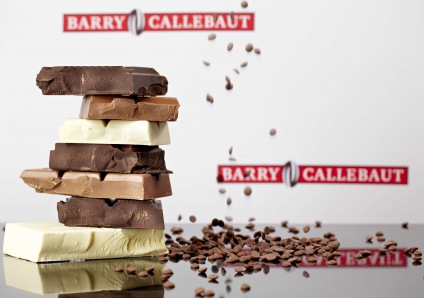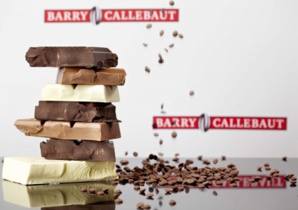- I thought, if we want to sell our products in China or India, we need to change something, - quotes Bloomberg Frederic Depypere, the head of research department.
According to him, the new kind of chocolate does not melt even at 38 degrees Celsius.
The main challenge for manufacturers was to preserve the taste of chocolate when changing its physical properties. Barry Callebaut claims that they could make chocolate, which can withstand up to 55 degrees, but this option was rejected because of poor taste.
Barry Callebaut did not specify the way of how exactly the chocolatiers reached the desired ratio of taste and temperature resistance, noting only that they work with the ratio of fat in the composition, just like everyone does.
It is expected that the chocolate market in Asia-Pacific, Latin America, the Middle East and Africa will have grown by more than 50% to $ 48 billion by 2019. Given the hot climate of these countries, many companies are working to develop chocolate that would not melt in such a heat. In particular, Nestle said that within three years, they may begin to supply shops with the chocolate that can survive a temperature of 40 degrees Celsius.
Plain chocolate softens at 28ºC, and at 32-25 ºC already is being melted, which makes storage and transportation quite a challenge. In the hot season or just in a hot country, chocolate requires refrigerators. Otherwise, it not only just melt away but lose its flavor as well.
Back in 1930, the US military called chocolatiers to create a sweet chocolate that would not be so sensitive to temperature - for the soldiers fighting, even in the tropics, could safely hold bar in his pocket and not worry that it will melt. Those or other modification of the "temperature stable chocolate" released by millions of copies since then and have been used in the composition of the diet not only in military, but also rescue, and even traveled to the moon. During the Gulf War, the Pentagon gave its army Congo Bar stable chocolates.
In fact, it turned out that the chocolate can be easily adapted, easily enough making it more resistant to melting. It is more difficult to get people to eat – even soldiers pointed that they are not keen on the eating of such a product. The problem the chocolate needs to be added a lot of fillers to make it stable- such as oat flour - and fusible cocoa butter is replaced with other fats. This chocolate tastes like paraffin candle.
A patent, obtained recently by British developers of Cadbury, is based on a completely different approach. The fact that the chocolate mass, already mixed and crushed, is stirred at high temperature. This is a lengthy process, it can take from a quarter of an hour to several days. During this time, the chocolate interacts with oxygen in the air, and change its chemical and physical properties.
In particular, the microparticles are completely sugar coated with a thin layer of oil, so that they easily stick to each other - and just as easily come off, softening. The improved process proposed Cadbury, is not to refined oils before and after conching. Experiments have shown that a chocolate and after three hours at 40º C is solid, so that the fingers do not leave traces of dents on it. This saves and tender texture, and liked the taste.
According to him, the new kind of chocolate does not melt even at 38 degrees Celsius.
The main challenge for manufacturers was to preserve the taste of chocolate when changing its physical properties. Barry Callebaut claims that they could make chocolate, which can withstand up to 55 degrees, but this option was rejected because of poor taste.
Barry Callebaut did not specify the way of how exactly the chocolatiers reached the desired ratio of taste and temperature resistance, noting only that they work with the ratio of fat in the composition, just like everyone does.
It is expected that the chocolate market in Asia-Pacific, Latin America, the Middle East and Africa will have grown by more than 50% to $ 48 billion by 2019. Given the hot climate of these countries, many companies are working to develop chocolate that would not melt in such a heat. In particular, Nestle said that within three years, they may begin to supply shops with the chocolate that can survive a temperature of 40 degrees Celsius.
Plain chocolate softens at 28ºC, and at 32-25 ºC already is being melted, which makes storage and transportation quite a challenge. In the hot season or just in a hot country, chocolate requires refrigerators. Otherwise, it not only just melt away but lose its flavor as well.
Back in 1930, the US military called chocolatiers to create a sweet chocolate that would not be so sensitive to temperature - for the soldiers fighting, even in the tropics, could safely hold bar in his pocket and not worry that it will melt. Those or other modification of the "temperature stable chocolate" released by millions of copies since then and have been used in the composition of the diet not only in military, but also rescue, and even traveled to the moon. During the Gulf War, the Pentagon gave its army Congo Bar stable chocolates.
In fact, it turned out that the chocolate can be easily adapted, easily enough making it more resistant to melting. It is more difficult to get people to eat – even soldiers pointed that they are not keen on the eating of such a product. The problem the chocolate needs to be added a lot of fillers to make it stable- such as oat flour - and fusible cocoa butter is replaced with other fats. This chocolate tastes like paraffin candle.
A patent, obtained recently by British developers of Cadbury, is based on a completely different approach. The fact that the chocolate mass, already mixed and crushed, is stirred at high temperature. This is a lengthy process, it can take from a quarter of an hour to several days. During this time, the chocolate interacts with oxygen in the air, and change its chemical and physical properties.
In particular, the microparticles are completely sugar coated with a thin layer of oil, so that they easily stick to each other - and just as easily come off, softening. The improved process proposed Cadbury, is not to refined oils before and after conching. Experiments have shown that a chocolate and after three hours at 40º C is solid, so that the fingers do not leave traces of dents on it. This saves and tender texture, and liked the taste.






